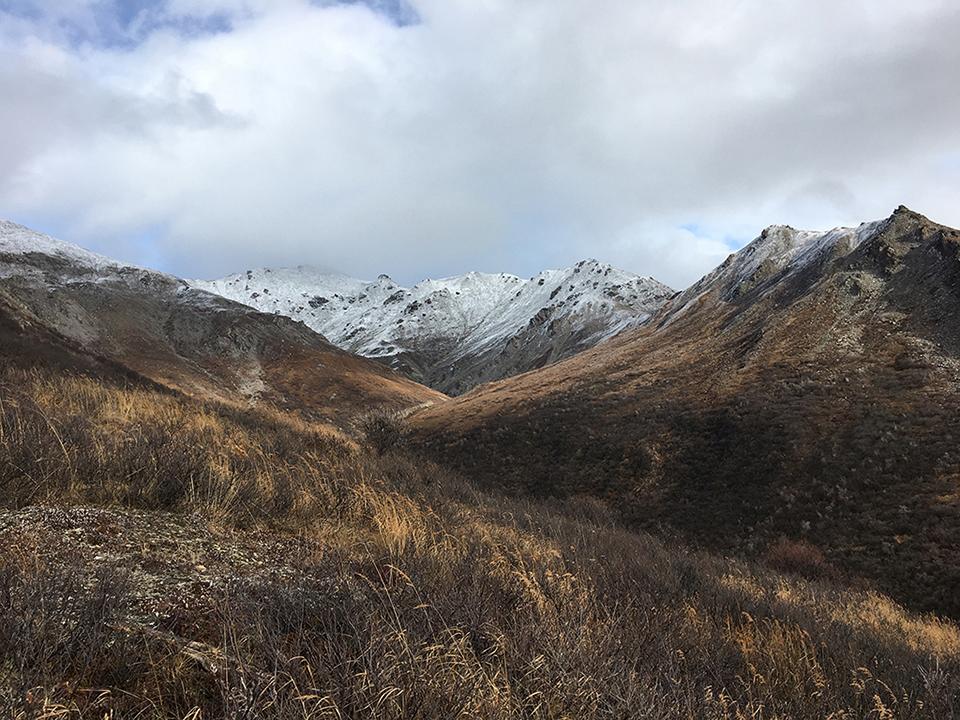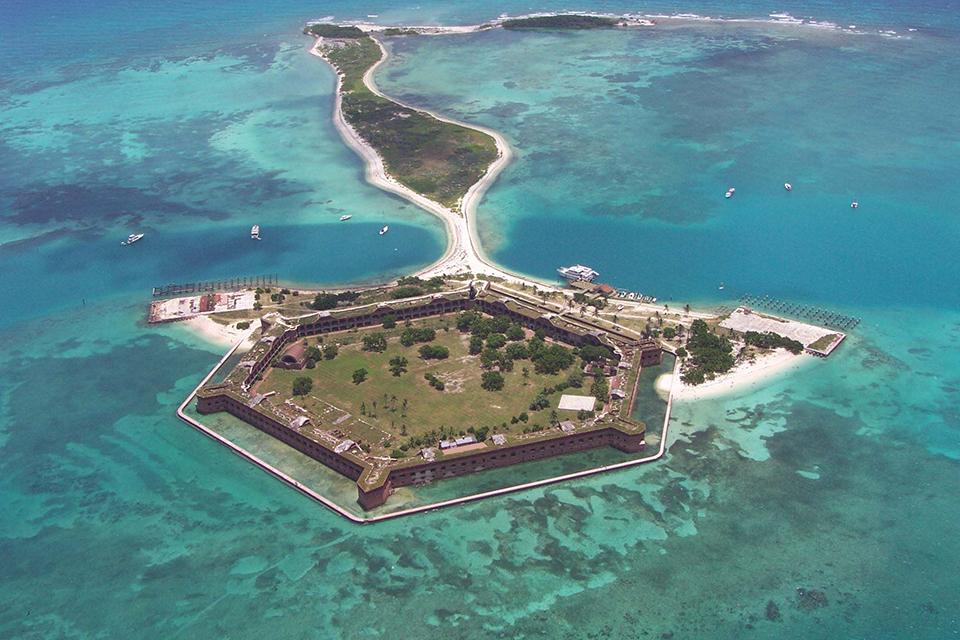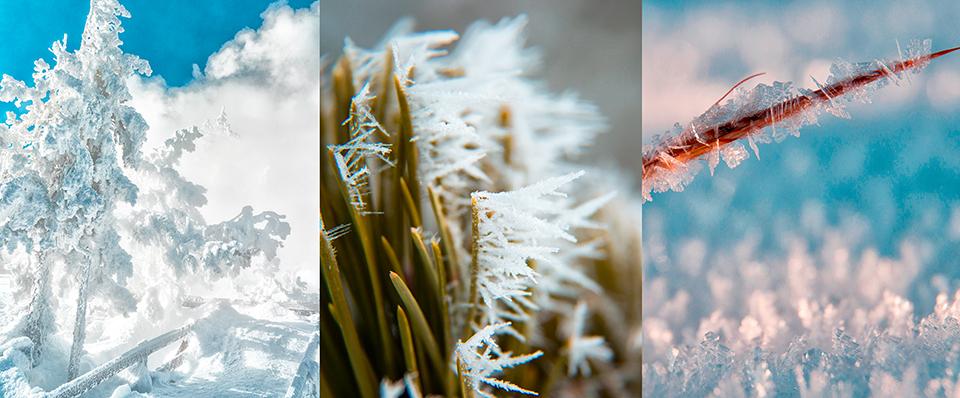
One very icy little tree at Upper Geyser Basin, Yellowstone National Park / Rebecca Latson
Now that it’s winter, how about a seasonally-themed quiz and trivia piece. While thinking nice, warm thoughts and sipping your hot cocoa, see just how much you know about national parks and winter before checking the answers at the bottom of the page to this chilly quiz. Maybe you’ll even learn something new!
1. True or False: rime ice is another name for hoar frost.
a) True
b) False

You might see these ice features along the shores of Lake Superior, Pictured Rocks National Lakeshore / NPS
2. While walking the shores of Lake Superior at Pictured Rocks National Lakeshore during the winter, you might notice round-ish, rimmed plates of ice on the water. This phenomenon is known as ___.
a) Shield ice
b) Pancake ice
c) Platelet Ice
d) Laminate Ice

Snow in the mountains, Denali National Park and Preserve / NPS - Katie Karnes
3. When snow first falls on the landscape at Denali National Park and Preserve, this is known as:
a) Peak dust
b) Winter start
c) Winter laminate
d) Termination dust

Pika food for the winter, Lassen Volcanic National Park / Rebecca Latson
4. Pika do not hibernate during the winter. Instead, they collect vegetation, including seeds, grasses, and other dried plants, creating a ____ from which they will feed all winter long.
a) Haypile
b) Cache
c) Haystack
d) Winter gnosh pit

Snow at the historic entrance of Mammoth Cave National Park / NPS - Kait Evensen
5. It may be snowy cold over the landscape of Mammoth Cave National Park, but deep inside of the cave, away from the entrance, the temperature is a constant ___ degrees Fahrenheit.
a) 38 degrees F
b) 42 degrees F
c) 54 degrees F
d) 65 degrees F

Inside an ice cave, Apostle Islands National Lakeshore / NPS
6. Apostle Islands National Lakeshore in Wisconsin is famous for its ice caves along the shores of Lake Superior. Three things are necessary for the formation of these ice caves: open water (lots of it), really cold temperatures, and ___.
a) Plenty of salt in the water
b) Sand
c) Wave action
d) Wind

Fort Jefferson on Garden Key, Dry Tortugas National Park / NPS
7. While winter temperatures are nice and mild at Dry Tortugas National Park (no snow here, folks), it does get pretty windy. True or False: it is not uncommon for 40-knot (46 mph) winds to blow several consecutive days at this park, due to the strong “cold” fronts from the North and West.
a) True
b) False

A snowy December day at Paradise, Mount Rainier National Park / Rebecca Latson
8. The Paradise area of Mount Rainier National Park is considered one of the snowiest of the national parks and set a record back in 1971 – 1972 with a whopping ___ inches of snowfall.
a) 1,055
b) 1,087
c) 1,122
d) 1,543

A snow-blanketed Wizard Island, Crater Lake National Park / NPS
9. True or False: because Crater Lake in Crater Lake National Park is so deep with so much water volume, it’s never completely frozen over.
a) True
b) False
10. Yellowstone National Park experiences subfreezing winters, once setting a record temperature of ___ in the park.
a) -24 degrees F (-32 C)
b) -47 degrees F (-44 C)
c) -66 degrees F (-54 C)
d) -70 degrees F (-57 C)
Trivia

Reconstructed soldiers huts, Valley Forge National Historical Park / Kim O'Connell
Pennsylvania winters are cold, as George Washington and his troops discovered during their 1777 – 1778 winter encampment at what is now Valley Forge National Historical Park. “The winter of 1777-78 was not the coldest nor the worst winter experienced during the war, but regular freezing and thawing, plus intermittent snowfall and rain, coupled with shortages of provisions, clothing, and shoes, made living conditions extremely difficult. Rather than wait for deliverance, the army procured supplies, built log cabins to stay in, constructed makeshift clothing and gear, and cooked subsistence meals of their own concoction.” To learn more about this winter encampment at Valley Forge National Historical Park, check out this Traveler article.

A frosty-looking bison, Yellowstone National Park / Rebecca Latson
“When you think of winter, what comes to mind? Cold? Dark? Snow? Ice? Frost? In many regions across the country, the turn of the season brings frigid temperatures and harsh weather conditions. While we may head indoors to our cozy, climate-controlled homes when the weather turns frightful, wild animals don’t have that luxury. Instead, they use a few basic strategies [such as migration, hibernation, or adaptation] to survive the worst of winter.” Birds, caribou and humpback whales “travel thousands of miles by land, air, or sea to reach their winter destinations.” Other animals, like bears, bats, and wood frogs, go into a state of dormancy (hibernation, torpor) for the winter. And other forms of wildlife will adapt to the cold temperatures, growing thicker fur or an extra layer of fat, and even changing color to better camouflage themselves from predators. To read more about winter survival strategies, click here.

A female condor and her egg, Pinnacles National Park / NPS - Gavin Emmons
Winter can be a time for finding love – if you’re a condor. “Condors typically -- though not always -- form long-term bonds with one mate year after year. Mated pairs start the courtship process during the winter months; during this period, they will spend nearly all of their time together, preening each other and checking out potential nest sites … After a few weeks or months of courtship, a mated pair of condors chooses a suitable nesting site. They don’t build nests like many other birds, but instead find cavities in rocky cliffs or in the hollows of large redwood trees. Sometime between January and March, the female condor will lay a single egg in the nest cavity. Both parents take turns incubating the egg for two months until it hatches, and then continue to share parenting duties of their nestling for another six months in the nest until it fledges (learns to fly).”
Quiz Answers
1b False

Left to right: hard rime ice (Yellowstone National Park), soft rime ice (Yellowstone National Park), Hoar frost (Arches National Park) / Rebecca Latson, Neal Herbert, NPS
Rime ice and hoar frost look quite similar, but the creation of each is different. Hoar frost forms usually on cloudless, windless, cold nights, when water vapor comes into contact with solid surfaces already below the freezing point and creates ice crystals. These granular-looking ice crystals can build themselves up quite high and create lovely patterns surrounding a blade of grass or a tree branch or some other object. Rime ice, on the other hand, doesn’t need a clear, calm night. It just needs wind and subfreezing temperatures like the kind you can feel during a Yellowstone winter. Supercooled water droplets (like water droplets wafting away from a steamy hydrothermal source) rapidly freeze on impact with an object. Rime ice can build up thickly (hard rime) or appear fragile and spikey, extending quite a bit from the object upon which it froze (soft rime).
2b
According to forecast.weather.gov, pancake ice consists of “circular flat pieces of ice with a raised rim; the shape and rim are due to repeated collisions” from wave action.
3d
“Termination dust” refers to fall snow, signaling the end (or termination) of summer and the imminent arrival of winter.
4a, b, or c
While haypile is the most commonly-used term for the pile of food a pika collects for the winter, cache and haystack apply, as well. Some of these hay piles / haystacks / caches are larger than 4 feet and can weigh up to 60 pounds! Pika call many units of the National Park System home, including Lassen Volcanic, Yellowstone, Denali, and Rocky Mountain national parks.
5c
The temperature within Mammoth Cave is a constant 54 degrees F (12.2 C), making it feel downright balmy during winter, and cool during a hot, humid summer.
6d
Well, maybe this is a trick question, because it does take wave action to help create the fairyland-like ice caves at Apostle Islands National Lakeshore. But what makes that wave action? Wind! To learn more about these famous mainland ice caves and to see if they might be open 2022 / 2023, click here.
7b False
Ok, not counting hurricane-force winds, it’s not uncommon for Dry Tortugas National Park to experience 20-knot (23 mph) winds on consecutive days during the winter months. This means “rough seas and poor visibility when snorkeling.” To learn more about seasonal weather at Dry Tortugas, click here.
8c
Paradise once held the world record for measured snowfall in single year in 1971-1972: 1,122 inches (93.5 feet/28.5 meters). To read more about Paradise snowfall accumulations over the years, click here.
9b False
While it takes a very cold winter, indeed, to freeze the lake’s top, Crater Lake did indeed completely freeze over for about two months in 1949, and, according to the Crater Lake Institute, for four days in 1924.
10c
According to Yellowstone.org, the record low temperature for the park was -66 degrees F (-54 C) on February 9, 1933 (West Entrance, Riverside Station). Brrrrr!




 Support Essential Coverage of Essential Places
Support Essential Coverage of Essential Places






